7 Best LCR meter (Handheld & cheap 2025)
Every circuit has three major circuit components. These components are the resistor (R), inductor (L), and capacitor (C).
To properly place these components according to the circuit design values. We need to measure the values of these components.
To do so, we use a meter called the LCR meter.
Now if you are a beginner or buying an LCR meter for the first time. You may have a few if not a lot of questions about it. For example, which LCR meter to buy? What parameter to consider in the best LCR meter? What are the famous brands and so many more questions like these?
Well, in this article we will cover all these questions.
At the end of this article, you should be able to know:
- What are some best LCR meters out there
- Technical parameters to consider
- How to use an LCR meter properly
Sounds interesting? Then I am sure you will enjoy the rest of this article as well.
Let’s get started.
Best LCR meter
LCR is short for Inductance, Capacitance, and Resistance. It is a tool that us measure these quantities with accuracy.
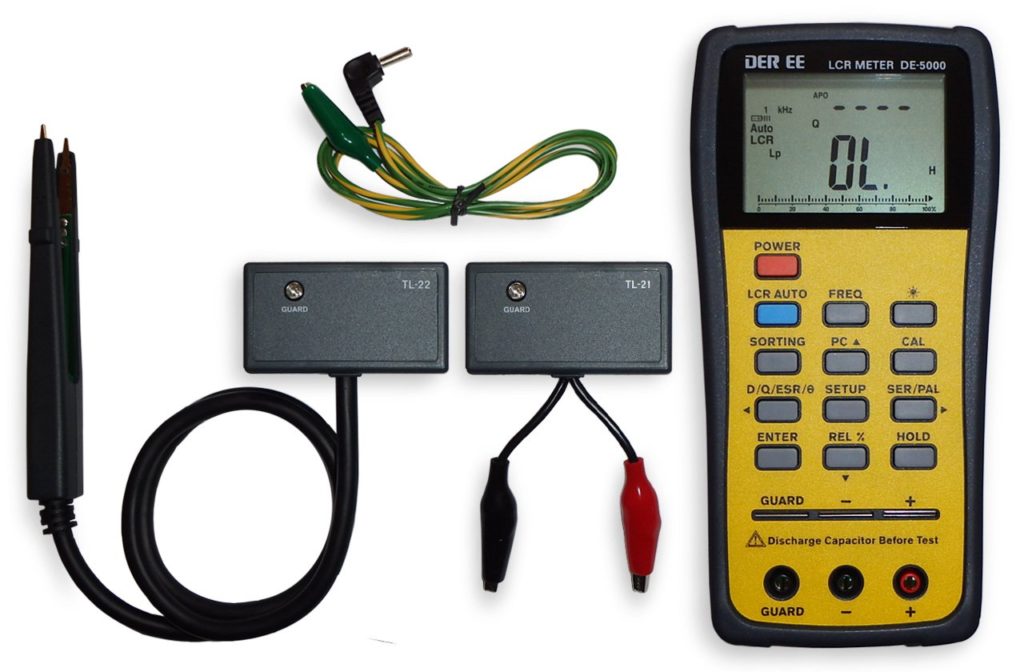
Now there are so options of LCR meters out there on the market that you can choose from.
But…
The best LCR meter that field professionals recommend is the DE-5000 ESR Meter or the Reed Instruments R5001. They are the best because they come from proven brands, are used by thousands of people, are of high quality, are reliable, and have a decent price tag that anyone can afford.
Alright!
Now, let’s talk in detail about these mentioned guys and see how they can be a lovely asset to your lab.
Choosing the best LCR meter
Deciding on the LCR meter may have many variables to consider. Like your personal budget and taste in electronic device design, and all those things.
Well, I can’t talk about those issues. What I can help you with is by sharing the technical parameter that makes an LCR meter stands out from the rest.
Following are the key things which think are necessary for a good quality LCR meter.
a. Series and parallel modes
Your LCR meter should have a series and parallel model for measurements. Because some measurements of Reactance need series models while some reactance needs a parallel model for high accuracy.
You will need these modes for the following situations:

Also, access to these models should be easy on your selecting LCR meter.
b. Frequency sorting
The next feature is frequency sorting. It means that your LCR should be able to make measurements at different frequencies. Like, every capacitor has its different testing frequency (which can be seen in its datasheet). To make measurements on that given testing frequency, the sorting option would be required on your LCR meter.
c. Easy calibration
It should be done with one button. Both the open and short calibration must not take that time and should be easy to do.
Calibration is needed when you try different types of probes or extension leads or things like these. When you do such things you actually bring extra external reactance. This must be calibrated for accurate results.
d. Easy to use
This is a must have feature. No one likes a meter that requires training. You have to look for a meter that is easy to use so that human errors can be eliminated to a possible level. So look for a meter that has automation and less manual work.
e. Bright display
If you are a total repair guy and busy all the time repairing devices then a good bright display will save you a lot more time. Also, sometimes we do measurements where we can’t see the display properly from an angle. So, make sure your LCR display is visible from all major angles.
f. Decent ranges
The meter must be a decent range of measurements on all the standard frequency spectrums. Like you should not invest in those meters that don’t have a capacitance range that you would work all the time.
g. Auto mode
By auto mode I mean there should be no manual selection of selecting capacitor, inductor, or resistance.
h. Friendly UI
This is not a deal-breaker, but a nice user interface is what the best LCR meter should have. As you know, a battery sign somewhere would be impressive so that you can update yourself about the battery status of the meter. The digits should have clear fonts and sizes. And UI should be very easy to interact with the meter and very easy to read the results in no time.
List of top LCR meters
I think I have shared all the information that I have about the topic. Now let’s have a look at some top digital wrenches. I will start with very basic digital LCR meters then I will talk about the intermediate models and then will end with some professional LCR meters. So please keep on reading.
Keep in mind, I am not going to repeatedly talk about the above must have features of the best LCR meter over again and again. They are applied to all the below mentioned models.
Also, I am not going to add some fancy-looking models that you will see a bunch of them online. Look man, I am an engineer and technical terms are more romantic than looks.
1. DE-5000 ESR Meter
Let’s start our list by introducing the DE-5000 best LCR meter from DER EE Electrical Instruments. DE-5000 is an LCR meter with a built-in auto function for ESR measurements.
You connect the capacitor you want to test, select esr, and there you have its ESR value.
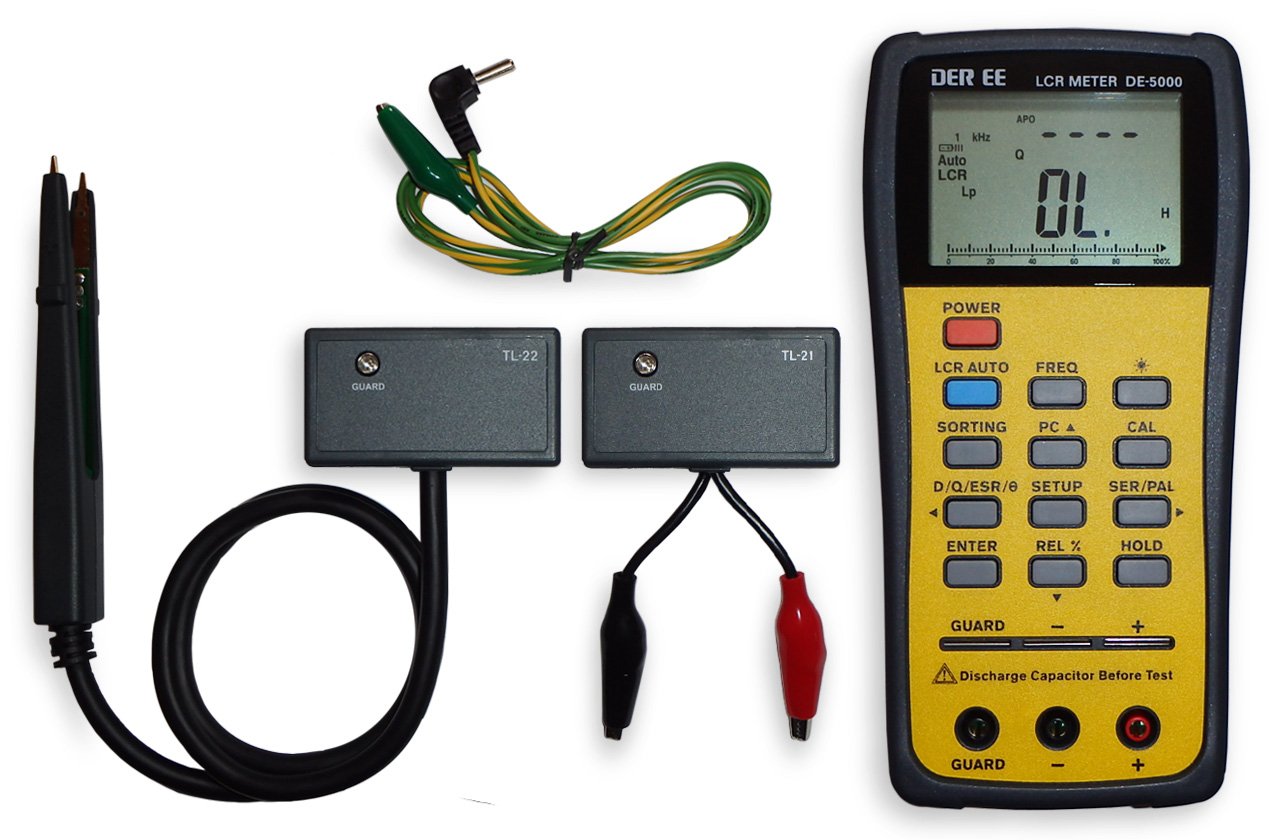
Important features:
- Fully auto operational for both AC Impedance and DC resistance.
- Variety range of test frequencies.
- It has frequency sorting and series/parallel modes
- High quality Guard lines.
You can further investigate this meter yourself. Here is the link for your own research, DE-5000 (Amazon link).
2. Reed Instruments R5001
The next best LCR meter is from the Reed instruments. It is called the R5001. This LCR meter measures inductance, capacitance, and resistance with secondary parameters such as dissipation factor (D), quality factor (Q), phase angle (Ø), and equivalent series/parallel resistance (ESR or Rp).
The R5001 features a large easy-to-read LCD with a backlight, and data hold/relative functions.
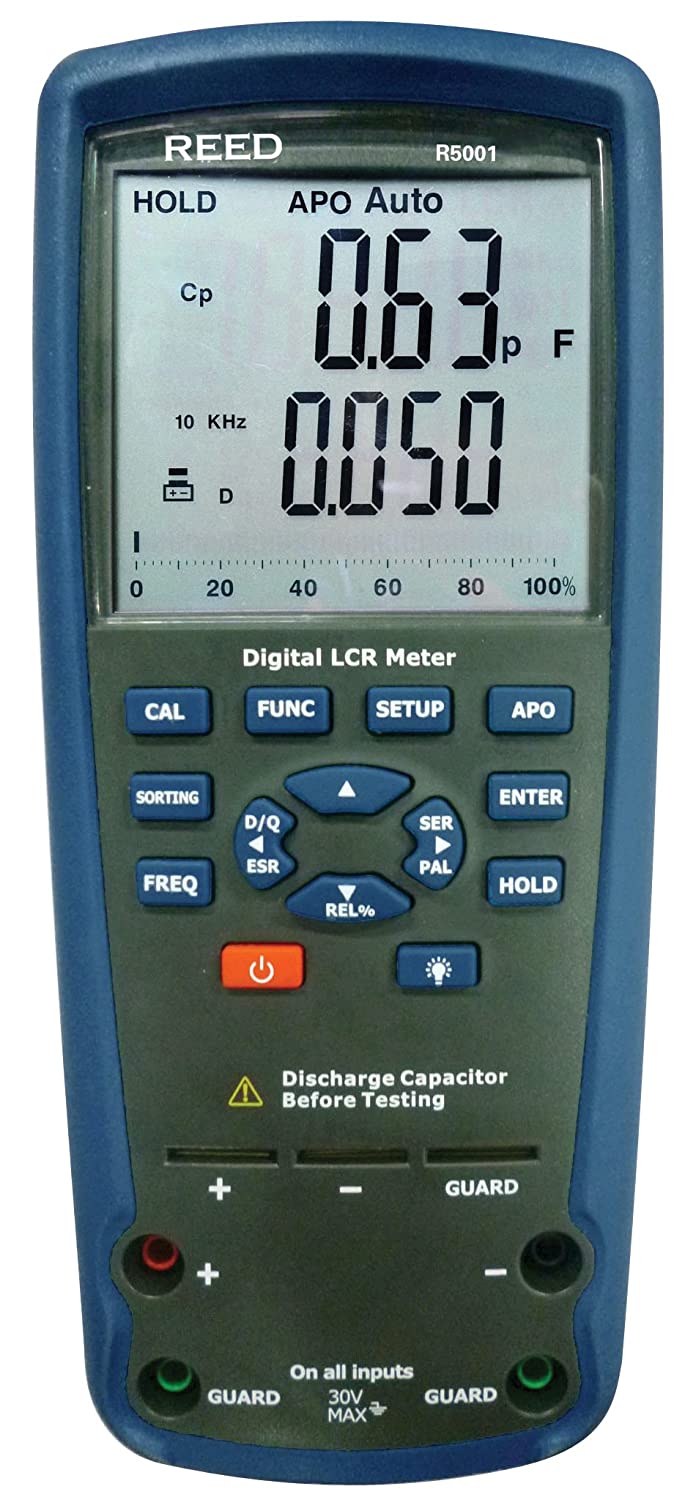
Some important features of this amazing LCR meter:
- High accuracy of 1.5%
- Both AC impedance and DC resistance measuring options with auto range selection.
- Industry-standard testing frequencies i.e., 10Khz up to 100KHz
- Ls/Lp/Cp with D/Q/Ø/ESR parameters
- Includes test leads, probes, tweezers, alligator clips and batteries – this is very amazing.
To know more about this LCR meter then here is the link for your own further research, Reed R5001 (Amazon link).
3. Extech 380193
The next top LCR meter is from the Extech brand.
Extech is another great manufacturer and is in business for decades. They make quality instruments which means you get a product that is reliable and has a long working life. The downside of it is of course the high price tag.
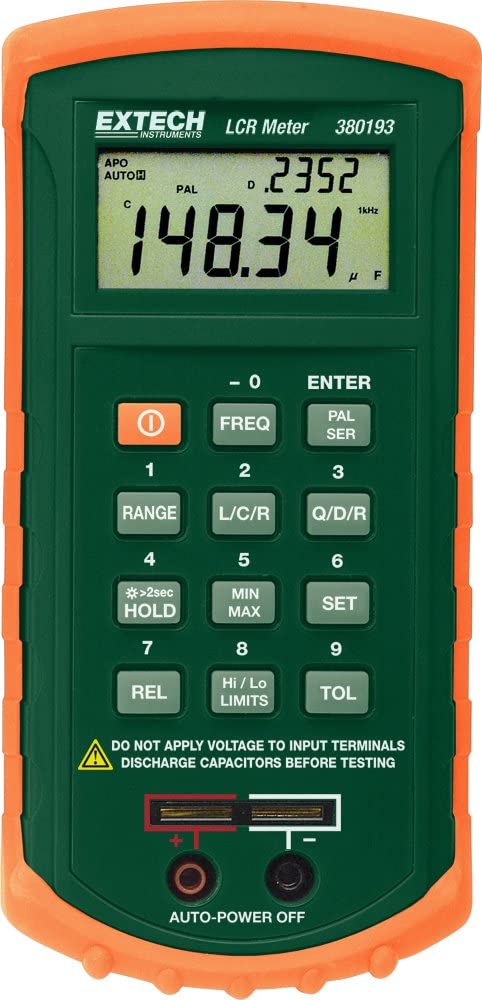
Important features:
- Got two displays: the primary display of inductance, capacitance, or resistance
- Secondary display of Q, dissipation (1/Q), and resistance
- Built in test fixture or use external test leads
- Test frequency accuracy 122.8Hz (±4Hz) and 1kHz (±4Hz)
- Protective Holster
In a short summary, the Extech – 380193 (Amazon link) is an amazing LCR meter. It can be used throughout an electronic component’s lifecycle including research and development, production, quality assurance, installation, and maintenance to ensure satisfactory performance.
4. MATRIX MCR-5100 Benchtop LCR Meter
The next LCR meter is benchtop LCR meter. Meaning if you are looking for more features, accuracy, and precision. Then this is the option for you.
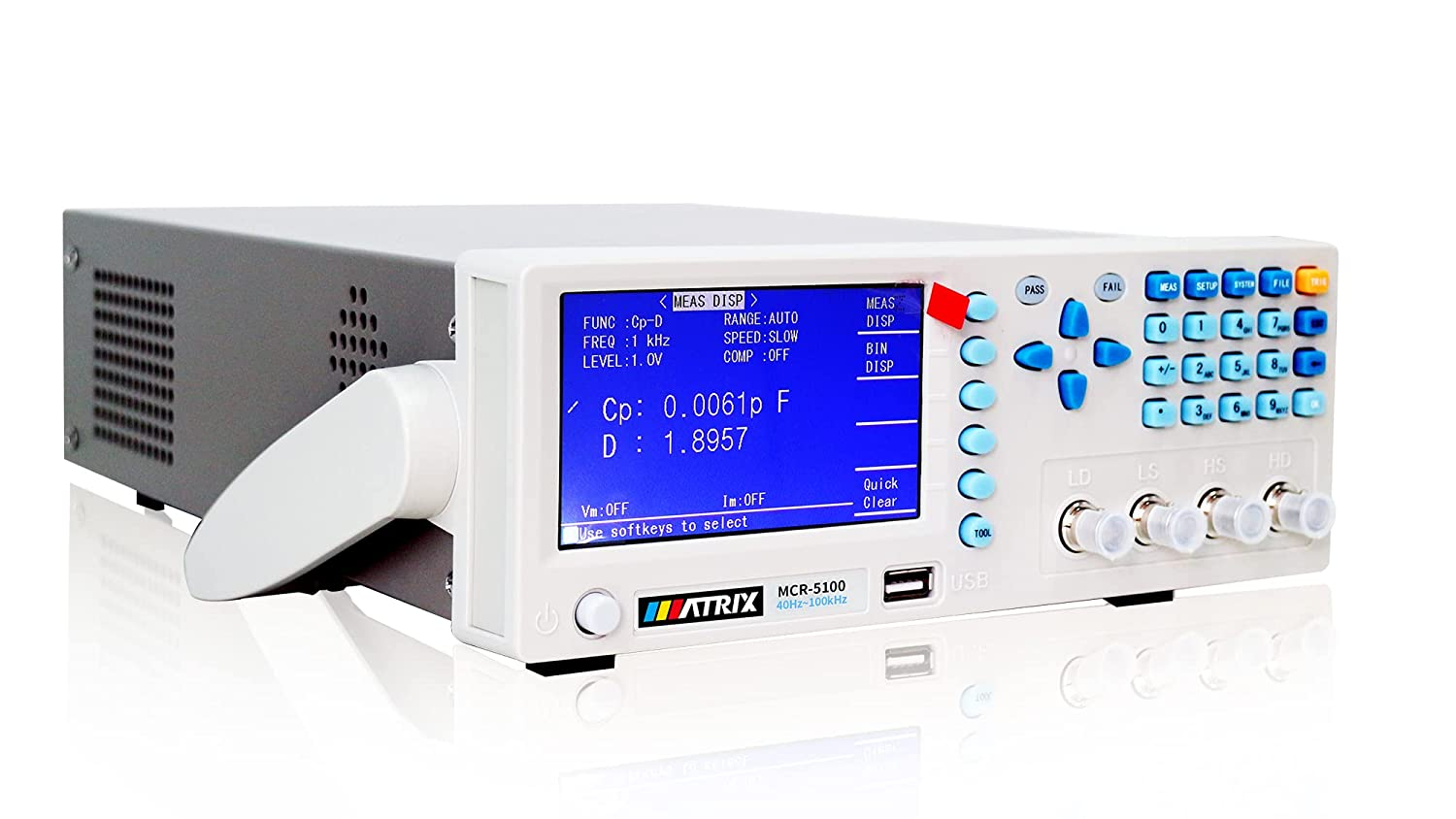
Important features:
- Built-in comparator
- Multiple frequency points from 40Hz-200kHz and 0.1% accuracy
- 5-level sorting flexible pass and bad alarm mode
- Shutdown automatically saves test conditions
- User friendly operation.
- Instrument software version, which can be upgraded through a U disk.
- 4.3-inch TFT LCD screen
In a short summary, the MATRIX MCR-5100 Benchtop LCR Meter (Amazon link) is one of the best benchtop LCR that has multi-frequency points and 0.1% accuracy to meet the testing needs of various components and parameters.
5. B&K Precision 880
B&K Precision is a very old company, and they are making some very quality tools for professionals and engineers for decades. The LCR meter from this brand is amazing and in my opinion, you should definitely check this guy out.
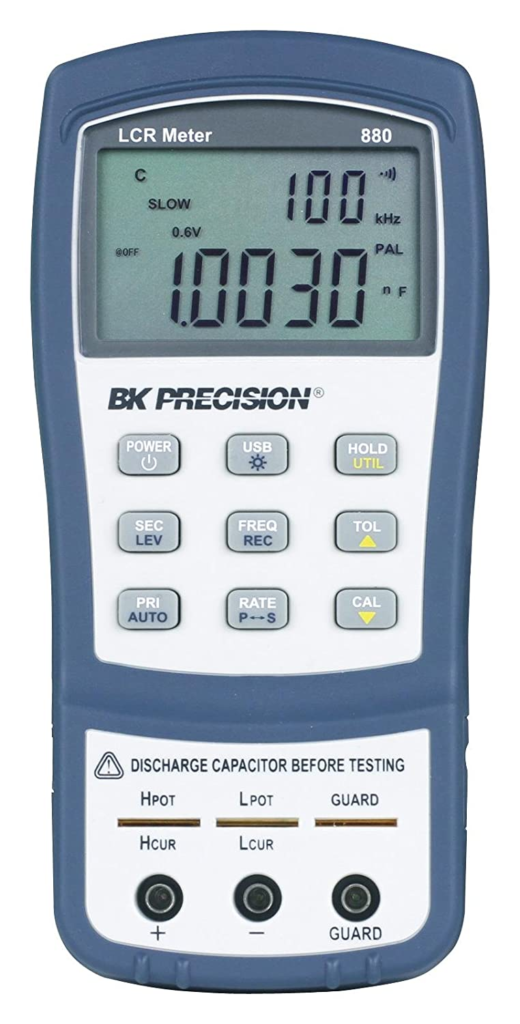
Important features:
- 40,000 counts resolution on the primary and 10,000 counts resolution on the secondary display
- Automatic calculation of secondary parameters D, Q, Theta, ESR (Theta/ESR for 879B &880 only), and DCR
- Accuracy up to 0.1% and selectable test frequencies up to 100 kHz
- Fast auto range design for rapid, easy component measurements
In short summary, the B&K Precision 880 (Amazon link) is a quality LCR meter that offers capabilities typically only found in bench LCR meters such as a 4-terminal configuration, basic measurement accuracy up to 0.1%, test frequencies up to 100 kHz, selectable test signal levels and measurement rate.
6. Hantek 1832C Handled LCR Meter
Hantek is a very popular brand among electronics professionals. They make a lot of high quality testing instruments for students, industrial and professional work.
The LCR from this brand, i.e., 1832C, is no different.
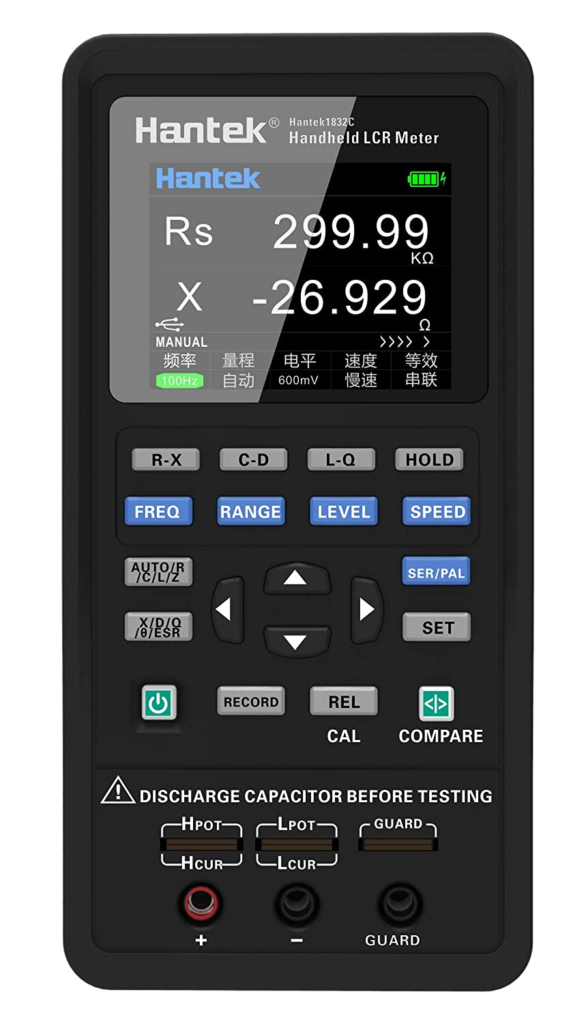
Important features:
- 0.6 Vrms test level
- 0.30% accuracy which is very amazing
- Primary display for L/C/R/Z, and the secondary display for X/D/Q/theta(P)/ESR
- Measurement range: 0-2000H(L), 0-20mF(C), 0-20M Omega(R)
- Reset function
- Open/short circuit calibration
- Fundamental modes: series and parallel
In summary, the Hantek 1832C Handheld LCR Meter (Amazon link) is an amazing option that is packed in a protective carrying case, this compact device fits in both an electronic toolbox and fieldwork.
Powered by a 5V lithium battery set, it can be charged fully within 2 hours and stands by for a long time, which makes it suitable for electric maintenance in remote areas.
7. LCR-58 Tweezer
The above LCR meters are designed for through hole capacitors, inductors, and resistors. But what if you want to test or measure SMDs components? Then you need LCR tweezers.
You know it is a lot easier to use a tweezer when working with SMDs or generally repairing a circuit board. Tweezer saves a lot of lot and effort. But the best part is it gives much more accuracy as there is no wire resistance involved. LCR-58 is an amazing LCR meter in the form of a smart tweezer.

Important features:
- Option for DCR measurements
- Easy to use
- High accuracy with better resolution
- Safety protection
Here is the link to know more about the amazing LCR tweezer LCR-58 (Amazon link).
How to use an LCR meter?
Using an LCR meter is easy and straightforward. But you have to keep certain things in mind before using it.
The first one is to discharge the capacitor fully before measuring its capacitance.
Discharge a capacitor fully
A capacitor is a charge storing device. Meaning that it can have stored charges even if it is not connected to the circuit.
So, it is very important to play safe with this component. Else it can give you an electric shock and can fully damage your measuring device.
After understanding the above threat of a highly charged capacitor we must know how to discharge a capacitor before working with it.
How to discharge a capacitor?
Well, there are a couple of ways in which you can discharge a capacitor.
For example:
- Using a screwdriver
- Using a discharge resistor
- Using a high resistance pliers
Steps of using an LCR meter for Capacitance
Alright!
Following are the steps using which we can measure the capacitance of the capacitor using an LCR meter.
- First, take your capacitor and discharge it. If you forget this step, you may actually harm yourself and can completely damage your LCR meter. So, never measure a charged capacitor.
- Take your LCR and set it on the capacitance feature or mode if it is not an auto one
- For electrolytic capacitors, connect the black probe (-) to the negative terminal of the capacitor and the red probe (+) to the anode of the capacitor
- For ceramic just connect the probes the way you like
- See the results on the display.
- The values may start from low and gradually increase. Take the highest value.
Every LCR has two screens. Primary screen will show the reading of capacitance. While you can check other related values on the secondary screen, for example the ESR value etc.
Steps of using an LCR meter for Inductance
Following are the steps using which we can measure the inductance of the given inductor using an LCR meter.
- First, take your inductor
- Take your LCR and set it on the inductance feature or mode if it is not an auto one
- Connect the probes the way you like
- See the results on the display.
- The values may start from low and gradually increase. Take the highest value of your inductance.
Steps of using an LCR meter for Inductance
Following are the steps using which we can measure the inductance of the given inductor using an LCR meter.
- First, take your resistor
- Take your LCR and set it on the resistance feature or mode if it is not an auto one
- Connect the probes the way you like
- See the results on the display.
Conclusion
If you design a circuit you will see that will have one of these components, resistor, capacitor, and inductors. Maybe not all but your circuit will have definitely one of these components.
The word LCR is short for Inductance Capacitance Resistance. Meaning this is an electronic device that we use to measure these three mentioned parameters.
- In the R mode, it can be your resistance or OHM meter
- In the C mode, it will be capacitance and ESR meter
- In the L mode, it will be your inductance meter
An LCR meter of high accuracy saves you both time and money in quality control, product testing, and effecting repair of some expensive electronic units.
Unlike the capacitance and resistance capabilities of a digital multimeter, an affordable yet reliable LCR meter provides added accuracy and the advantage of inductance.
Now to buy a new LCR meter, there are a few things you should keep in mind.
- Your LCR meter should have a series and parallel model for measurements.
- It should have an easy calibration system. Both the open and short calibration must not take that time and should be easy to do.
- To make measurements on that given testing frequency, the sorting option would be required on your LCR meter.
- Make sure your LCR display is visible from all major angles.
Now, using an LCR meter is very simple. You first select your testing frequency (a pre default is 10Khz). Then you just connect your component and get the readings.
Please keep in mind when you are measuring the capacitor with your LCR meter, discharge the capacitor.
- Discharging a capacitor is so important and crucial, if you accidentally forget this step, you may end up destroying your LCR meter.
- Discharging of a capacitor can be done by shorting its legs by any available means. But don’t just short the legs together with low resistance wire, a good practice is to use a high resistance material.
Alright!
Well…
That is it. That is all I have for you about some of the best LCR meters out there on the market. I hope you enjoyed it.
Thank you and have a grateful life.
Other useful posts:
